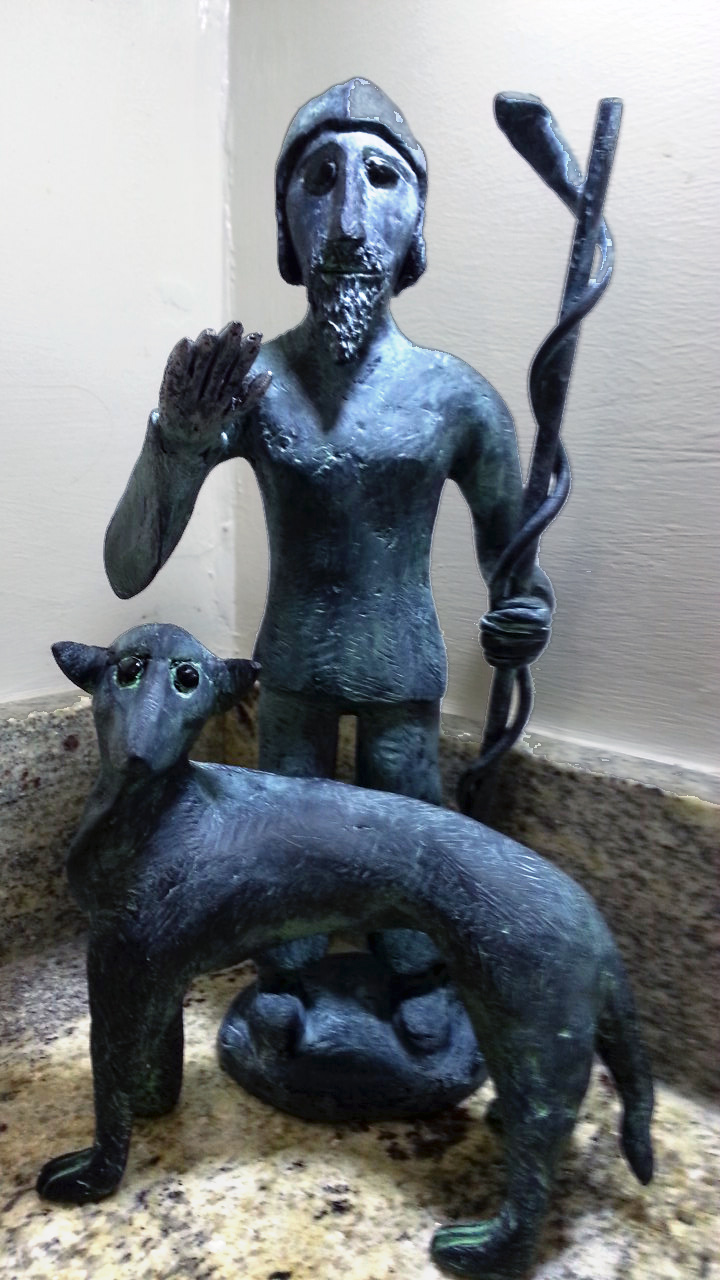
Nodens.
Herewith Nodens and his Hound, a study in faux bronze (milliput over iron and copper) made as part of my continuing druidical studies of the ancient pagan Gods and Goddesses of my area.
Nodens had a large temple by Romano-Celtic standards; just over the River Severn at Lydney on a promontory they call Ludd’s Island.
This temple probably functioned to invoke the healing powers of Nodens, it contained numerous votive offerings of models of body parts and some exquisite bronze models of hounds which the ancients venerated as agents of healing for their ability to lick their own wounds free of infection. The temple also appears to have included an Incubatio; a place in which to take ritual sleep, for perhaps prophetic or healing purposes.
Few images of Nodens have survived so I have given him an Asclepius style staff with serpent for his medical powers and the appearance of a grave and learned elder wizard. I do not intend to stray any closer to self-portraiture than this, and incidentally my normally shaggy hound did actually look like this two summers ago when the groomer gave her an all over haircut.
Nodens does however have a complex theometry. The hound may also symbolise an association with hunting, some mythologies associate him with the sea as well, and he has etymological and mythological associations in the Irish myths with Nuada , king of the Tuatha Dé Danann, and the Welsh king Lludd (Nudd) Llaw Eraint from the Mabinogion.
Both these figures lost a hand in battle and acquired a magical replacement made in Silver which enabled them to regain their kingships. Perhaps this relates to some sort of wounded-healer myth, or to a magical healing hand.
Nodens appears briefly in the Lovecraft Mythos as a sea god who can command Nightgaunts and who opposes Nyarlathotep, perhaps this relates to his powers to dispel nightmares.
Summer is Coming.
George Martin’s marvellously entertaining Game of Thrones series takes part of its inspiration from the 15th century English Wars of the Roses. The fictional land of Westeros vaguely resembles Britain and the great wall in the north of it has echoes of Hadrian ’s Wall.
The English Wars of the Roses arose as a dynastic conflict for the English throne between feudal lords with their own private armies who fell to fighting each other in large part because of the loss of their holdings in France following the English defeats in the Hundred Years War, as the French gradually consolidated their kingdom and eventually threw the English out.
The Game of Thrones has a different trigger for war, the advent of a decades long winter which creates a resource conflict. This scenario resembles the 17th century wars which raged across Europe and notably included the Thirty Years War which sucked in all the European powers, and the English Civil War era which also involved Scotland and Ireland.
Historians sometimes call these extensive and very bloody 17th century wars ‘The Wars of Religion’. However wars between Catholics and Protestants had simmered since the various reformations for some time before, and continued long afterwards. The major outbreaks of war in the 17th century also involved conflicts between the Great Houses and Monarchies of Europe which often led to alliances and rivalries which cut quite across religious lines and led to the most bloody and destructive wars in European history, far in excess of the destruction achieved in WW1 and WW2.
A period of Global Cooling leading to massive crop failures coincided with the disastrous wars of the 17th century and the armies of the time ravaged the lands, plundering food and resources and committing genocide as they went. Central Europe suffered appalling devastation and the English Civil War seems very far from civil, as half starving armies requisitioned and devoured all resources in their path and executed anyone standing in their way.
This period of Global Cooling, sometimes called The Little Ice Age probably had an anthropogenic origin. The European invasion of the Americas initiated a massive population crash there of perhaps 90% of the indigenous peoples, mainly through diseases imported by the Europeans. This led to a vast reforestation of previously cultivated areas and the sudden CO2 uptake crashed the climate.
As someone once said of the French Revolution, 'there's nothing more political than the price of a loaf of bread', and the more closely one examines the wars of the 17th century the more they look like a resource conflict with religion serving only to justify aggression. Political and religious opinions of course harden during resource conflicts but they do not initiate them. Any alien anthropologist examining WW2 would probably describe the whole event as simply an inter-tribal dispute about oil resources. Germany and Japan would probably not have developed extreme ideologies and gone to war if they had had access to copious supplies of cheap oil, as did their main adversaries America, Britain, and Russia.
The current situation in the Middle East, and to some extent in the whole Islamic world, derives from problems of resources. Most of the countries involved now have very high populations but not the industrial or agricultural resources to maintain them comfortably, particularly in the face of climate change.
Syria suffered severe droughts which destroyed much of its agriculture and livestock just before the civil war broke out there, now it suffers from a baroque conflict involving at least three major factions and interference from foreign powers, now including Turkey apparently bombing all three factions. Political and religious opinions have hardened into extremism, mass deaths of adversaries have become the unstated aim of the combatants, and it all begins to resemble the 17th century all over again, except that the drying of the area rather than the freezing of the area seems the underlying cause.
If we cannot as a species get Global Warming under control we can expect far more of this.
Beware the Long Summer.